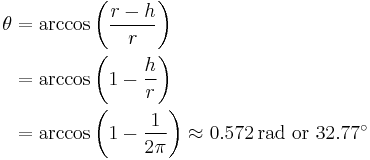Steradian
The steradian (symbol: sr) is the SI unit of solid angle. It is used to describe two-dimensional angular spans in three-dimensional space, analogous to the way in which the radian describes angles in a plane. The name is derived from the Greek stereos for "solid" and the Latin radius for "ray, beam".
The steradian, like the radian, is dimensionless because 1 sr = m2·m−2 = 1. It is useful, however, to distinguish between dimensionless quantities of different nature, so in practice the symbol "sr" is used where appropriate, rather than the derived unit "1" or no unit at all. For example, radiant intensity can be measured in watts per steradian (W·sr−1). The steradian was formerly an SI supplementary unit, but this category was abolished from the SI in 1995 and the steradian is now considered an SI derived unit.
Contents |
Definition
A steradian can be defined as the solid angle subtended at the center of a unit sphere by a unit area on its surface. For a general sphere of radius r, any portion of its surface with area A = r2 subtends one steradian.[1]
Since A = r2, it corresponds to the area of a spherical cap (A = 2πrh) (wherein h stands for the "height" of the cap), and the relationship h/r = 1/(2π) holds. Therefore one steradian corresponds to the plane (i.e. radian) angle of the cross-section of a simple cone subtending the plane angle 2θ, with θ given by:
This angle corresponds to the plane aperture angle of 2θ ≈ 1.144 rad or 65.54°.
Because the surface area of a sphere is 4πr2, the definition implies that a sphere measures 4π ≈ 12.56637 steradians. By the same argument, the maximum solid angle that can be subtended at any point is 4π sr. A steradian can also be called a squared radian.
A steradian is also equal to the spherical area of a polygon having an angle excess of 1 radian, to 1/(4π) of a complete sphere, or to (180/π)2 ≈ 3282.80635 square degrees.
The solid angle (in steradians) subtended by the cone above (whose cross-section subtends the radian angle 2θ) is given by:
Analogue to radians
In two dimensions, the angle in radians is related to the arc length it cuts out:
-
- where
- l is arc length, and
- r is the radius of the circle.
Now in three dimensions, the solid angle in steradians is related to the area it cuts out:
-
- where
- S is the surface area, and
- r is the radius of the sphere.
SI multiples
Steradians only go up to 4π ≈ 12.56637, so the large multiples are not usable for the base unit, but could show up in such things as rate of coverage of solid angle, for example.
| Multiple | Name | Symbol | May be visualized as... |
|---|---|---|---|
| 101 | decasteradian | dasr | Slightly more than the surface area of all water on Earth, relative to Earth |
| 100 | steradian | sr | Area of Asia, relative to Earth |
| 10−1 | decisteradian | dsr | Area of Argentina + Peru, relative to Earth |
| 10−2 | centisteradian | csr | Area of Paraguay, relative to Earth |
| 10−3 | millisteradian | msr | Area of Switzerland, relative to Earth |
| 10−6 | microsteradian | µsr | Area of Santa Monica, California, relative to Earth |
| 10−9 | nanosteradian | nsr | About 8 American football fields, relative to Earth |
| 10−12 | picosteradian | psr | Area of a small apartment, relative to Earth |
| 10−15 | femtosteradian | fsr | Area of a sheet of A5 paper, relative to Earth |
| 10−18 | attosteradian | asr | Area of a quarter-inch square, relative to Earth |
| 10−21 | zeptosteradian | zsr | Cross-sectional area of 32 gauge wire, relative to Earth |
| 10−24 | yoctosteradian | ysr | Surface area of a red blood cell, relative to Earth |
References
- ^ "Steradian", McGraw-Hill Dictionary of Scientific and Technical Terms, fifth edition, Sybil P. Parker, editor in chief. McGraw-Hill, 1997. ISBN 0-07-052433-5.
|
||||||||||||||||||||



